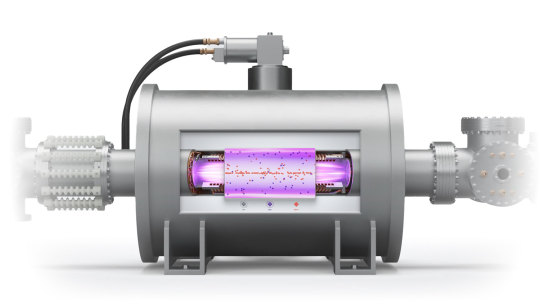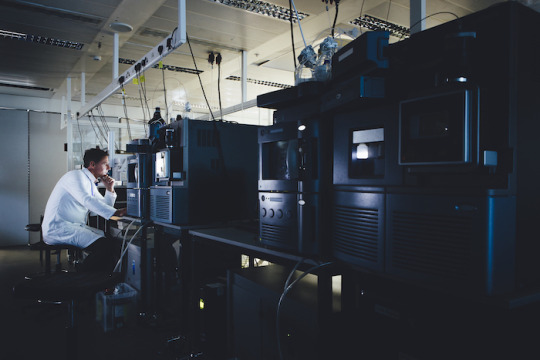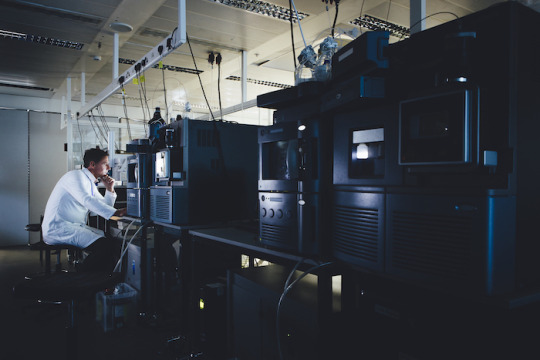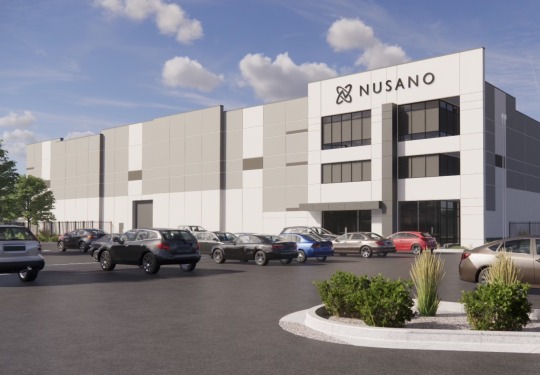Nusano is combining time-proven technology from universities and world-class research centers with our own breakthrough, patented particle acceleration technology.
Don't wanna be here? Send us removal request.
Text
The Global Demand for Cancer Radioisotopes: A Growing Medical Need

If someone told you a decade ago that tiny radioactive particles could selectively seek out and destroy cancer cells while leaving healthy tissue mostly untouched, you might have raised an eyebrow. However, today, that’s exactly what medical radioisotopes are doing, and they are changing lives across the globe. The growth in technology and the advancement of medical science have made it possible for healthcare providers to treat cancer with precision, and medical radioisotopes are one of these treatments. How? Read on to find out!
The Role of Medical Radioisotopes
Medical radioisotopes are radioactive substances used for diagnosing and treating diseases, especially cancer. In diagnostics, they allow physicians to visualize tumors through PET and SPECT scans. In treatment, certain radioisotopes deliver targeted radiation to cancer cells with minimal harm to surrounding tissues, and this is known as targeted radionuclide therapy.
This dual capability of diagnosis and therapy is known as theranostics, and it is making radioisotopes an increasingly vital part of modern oncology.
As more and more oncologists and treatment centers adopt radioisotope-based therapies, the global demand for radioisotope productionis also surging. Patients are living longer, earlier diagnosis is improving, and personalized cancer treatment is no longer a futuristic dream- it’s a present-day reality.
Why Radioisotope Supply Chains Are Uniquely Fragile?
The success of radioisotopes in cancer treatment has brought a unique challenge: a disrupting radioisotope supply chain that’s struggling to keep pace. Unlike most medicines, radioisotopes can’t be mass-produced and stored. Their short half-lives mean they must be produced regularly and used quickly. For example, Fluorine-18, used in PET scans, has a half-life of just under two hours, which means efficient and reliable production and distribution are crucial. Delays in delivery can lead to interrupted treatments, and this can prove life-threatening in cancer care.
In Focus: Actinium-255 and Lutetium-177
Two of the most promising therapeutic isotopes today are:
Actinium-255 is used in targeted alpha therapies, especially for Leukemia and prostate cancer. It emits high-energy particles that destroy cancer cells with extreme precision.
Then there’s Lutetium-177, which is used for neuroendocrine tumors and metastatic prostate cancer. Its low-energy beta emissions make it ideal for precision treatment with minimal side effects.
However, both face production bottlenecks. A reliable Ac-225 supplier or Lu-177 supplier is difficult to find, as only a few facilities can produce these isotopes at scale.
The Human Impact of Delayed Access
Behind every delayed shipment or production shortfall is a person in need- a father with advanced prostate cancer, a teenager battling a rare tumor, a mother hoping for a longer life. The promise of medical radioisotopes is profound, but without a stable global supply, that promise can’t be fulfilled.
Looking Ahead
New research in isotope separation, mini cyclotrons, and AI-optimized logistics could transform the landscape. The power of medical radioisotopesin cancer care is undeniable, but so is the need for global action to support sustainable care. Radioisotopes may be tiny, but their impact is massive, which is why Nusano’s patented technologies and methods are supplying the fight against cancer by transforming radioisotope production.
Source: https://nusanous.blogspot.com/2025/05/the-global-demand-for-cancer.html
0 notes
Text
How Medical Radioisotopes Are Changing the Way We Fight Cancer

The word “radioisotope” may sound like it’s part of space tech, or is part of a sci-fi movie, but that’s not the case. Radioisotopes have a profound use in cancer treatment. Medical radioisotopes are quietly revolutionizing the way cancer is diagnosed and treated, and they are doing it in nothing short of incredible. Wondering how? Well, here’s a guide to help you understand the process better.
What Exactly Are Medical Radioisotopes?
Medical radioisotopes are primarily unstable atoms that emit radiation. They are used in the diagnosis of different diseases, especially cancer, and what makes them unique is their ability to target specific organs or tissues when they are introduced into the body, so medical professionals can get an accurate image or offer targeted therapy.
Certain isotopes release radiation strong enough to kill cancer cells. These are typically delivered directly to the tumor, sparing most of the healthy tissue around it, and this targeted approach reduces side effects and improves outcomes. Commonly used medical radioisotopes include Technetium-99m (for imaging), Lutetium-177, Actinium-225, and Astatine-211 (for therapy). The field is growing rapidly, with ongoing research into more efficient production of radioisotopes to meet rising medical demand.
Targeted Treatment With Fewer Side Effects
One of the biggest game-changers in using radioisotopes for cancer treatment is precision. When conventional radiation therapy is used, healthy tissues often get caught in the crossfire. However, medical radioisotopes like lutieum-177 are used to target tumors directly, hence minimizing damage to the surrounding cells.
Thanks to advancements in lutetium 177 production, doctors can now offer personalized treatments that are effective as well as gentler on the body. This approach, known as theranostics, combines diagnostics and therapy in one smart package. First, doctors use one isotope to locate cancer cells, and then they follow up with another to treat them. It’s super-efficient, effective, and in many cases, life-saving.
The Supply Chain Struggle
Here’s the catch: the radioisotope supply chain is notoriously complex. These isotopes have short half-lives, which means they decay quickly and must be produced and delivered just in time. That’s where things get tricky.
Hospitals and clinics rely on a smooth supply chain, which depends heavily on a limited number of production facilities worldwide. If one reactor shuts down, it can cause a ripple effect across the globe. This is why reliable partnerships with an At-211 supplier or an Ac-225 supplier become absolutely essential to avoid treatment delays.
Why is It Crucial to Scale Production?
To meet the growing demand, the production of radioisotopes has to be ramped up, and this means investing in new reactors, improving manufacturing techniques, and exploring decentralized production methods, like compact particle accelerators.
By creating a more localized and reliable system, we reduce dependency on a fragile global network. More consistent access means more patients can benefit from these cutting-edge treatments without delay or disruption.
Conclusion
The idea that radiation could be used not just to detect but to treat cancer so precisely was once a dream. Now, thanks to medical radioisotopes, it’s a reality. With continued innovation in the field and stronger support for the supply chain, we are heading into a future where cancer treatments are smarter, safer, and more successful.
One company leading the charge is Nusano, a next-generation isotope production company focused on solving the radioisotope supply shortage. By creating more efficient ways to produce critical isotopes, Nusano is helping ensure that hospitals and research centers don’t have to face treatment delays due to limited availability.
Source: https://nusanous.blogspot.com/2025/04/how-medical-radioisotopes-are-changing.html
0 notes
Text
Radioisotope Shortages: What’s Causing the Crisis and How to Solve It?

The global healthcare industry is facing a massive crisis: a shortage of radioisotopes. Radioisotopes have tremendous significance in diagnosing and treating different medical conditions, including cancer, heart disease, and neurological disorders. However, the radioisotope supply chain is struggling with short supply due to different factors.
This shortage is affecting healthcare providers and patients alike, which raises concerns about the future availability of these life-saving materials. This is why we are here to understand why we are running low on these critical isotopes, and most importantly, what can we do about it.
Why is There a Shortage of Radioisotopes?
More than 50 million nuclear medicine procedures take place annually and the demand for radioisotopes is increasing.
However, several factors are responsible for causing radioisotope shortage, and unfortunately, it’s not a quick fix. These include:
Aging Infrastructure: Most of the facilities that produce radioisotopes, like nuclear reactors and particle accelerators are decades old. You won’t believe it, but some have been running for over five decades. As you can already imagine, keeping them operational is rather expensive and breakdowns are becoming more frequent. This is why instead of investing in modern infrastructure, professionals have been patching up these aging systems, which isn’t a long-term solution.
Too Few Suppliers: Here’s another issue: there are only a handful of Lu-177, At-211 suppliers, Ac-225 suppliers, and only a few places in the world that produce these isotopes. This means that if just one facility has a problem, the entire supply chain is thrown into chaos.
It’s Not Easy to Make Isotopes: The production of radioisotopes is complicated. While some isotopes are made in nuclear reactors, others require particle accelerators. For instance, the lutetium-177 production involves a delicate process of bombarding ytterbium-176 with neutrons, and even one misstep in the process can delay the supply.
Strict Regulations: The paperwork is rather overwhelming too. As radioisotopes are radioactive materials; they are tightly regulated for all the good reasons. However, these regulations can slow things down- producers struggle to get approval for production, transportation and handling takes time. Even if a facility is capable of producing isotopes, red tape can delay getting them into hospitals and patients who need them.
Nusano as the Solution
The good news? Companies like Nusano are stepping up to solve this crisis. Nusano is taking a fresh approach to isotope production, using cutting-edge particle accelerator technology to make the process faster, more efficient, and more reliable.
Unlike traditional suppliers that rely on aging reactors, Nusano is creating a more scalable and decentralized system. This means more isotopes, fewer shortages, and a more stable supply for the medical industry, ensuring that these critical materials are available when they are needed most.
A More Secure Future for Medical Radioisotopes
Fixing the radioisotope shortage isn’t going to happen overnight. We need new infrastructure, updated regulations, and, most importantly, innovation. That’s exactly what Nusano is bringing to the table. By revolutionizing the way isotopes are produced, Nusano is ensuring that hospitals, doctors, and patients don’t have to worry about shortages. The future of nuclear medicine depends on solutions like this, and thanks to forward-thinking companies, we are heading in the right direction.
Source: https://nusanous.blogspot.com/2025/03/radioisotope-shortages-whats-causing.html
0 notes
Text
The Growing Demand for Medical radioisotope production

Did you ever take a moment to think about how the new-age cancer treatments work? The answer is with medical radioisotopes. These tiny powerhouses, especially astatine-211 (At-211), actinium-225 (Ac-225), and lutetium-177 (Lu-177) are changing the game, when it comes to fighting cancer. However, as their demand for medical radioisotopes skyrockets, it has become crucial to ensure a steady supply of these radioisotopes. This is why the production of radioisotopes is evolving to keep up with the demand.
Why is Everyone Talking About Targeted Radiotherapy?
Conventional cancer treatments like chemotherapy and radiation can be tough on the body, as they can hit healthy cells along with the cancerous ones. However, what if we could directly attack cancer cells with pinpoint precision? That’s exactly what medical radioisotopes allow us to do. Fortunately, with growing innovations, more and more healthcare providers are on the lookout for At-211 and Ac-225 suppliers to meet patient needs without any setbacks.
The Buzz Around At-211
At-211 is a powerful alpha-emitting isotope that’s used in targeted alpha therapy (TAT) to tackle cancers like leukemia, gliomas, and prostate cancer. As the radioisotope has a short half-life) just 7.2 hours), a strong supply chain is essential to get where the radioisotope needs to go fast.
Researchers are actively improving the cyclotron-based production of radioisotopes to ensure a seamless pipeline from lab to patient. However, many industry leaders have also put their hands forward to ensure that the At-211 supplier network remains strong.
Ac-225 Demand
If there’s one isotope making headlines, it’s Ac-225. Why? Because it delivers highly localized radiation that’s super effective in treating aggressive cancers like prostate cancer and leukemia. However, finding a dependable Ac-225 supplier is easier said than done. Right now, production relies on a handful of sources like nuclear reactors and particle accelerators, but researchers are working hard to scale up the production of radioisotopes to meet rising demand. Imagine a future where Ac-225 is readily available for every patient who needs it, well that future isn’t far off.
The Growing Need for Lu-177 in the USA
Lu-177 is another game-changer, especially in treating neuroendocrine tumors and prostate cancer. Its balanced radiation energy makes it perfect for targeted therapy. With demand soaring, healthcare facilities across the country are searching for a consistent Lu-177 supplier in the USA. The good news? Both the U.S. Department of Energy and private pharmaceutical companies are stepping up to expand domestic production, hence reducing the reliance on imports and ensuring that patients get timely access to life-saving treatments.
Conclusion
So, where do we go from here? Nusano is supplying the fight against cancer with its patented technologies. We are talking about technologies that play a massive role in ushering in a thrilling new era in healthcare. In fact, their radioisotopes are supporting advancements in medicine in a controlled and predictable way that can be harnessed for useful means. Looking for an At-211 or a Lu-177 supplier in the USA? Reach out to the team at Nusano today!
Source: https://nusanous.blogspot.com/2025/02/the-growing-demand-for-medical.html
0 notes
Text
Nusano: Supplying the Fight Against Cancer
Nusano is a medical technology company that creates radioisotopes—tiny tracers used by doctors to diagnose and treat cancer and other diseases. Doctors use these tiny tracers like flashlights to light up areas inside the body. For more information visit: https://nusano.com/
0 notes
Text
How Radioisotopes Are Changing Cancer Treatment?

There’s no denying that cancer treatment has come a long way since the initial days. From invasive surgeries to precision therapies, the evolution of cancer treatment has been nothing short of remarkable. In this niche, medical radioisotopes have been a game-changer. You may not hear about them as much as chemotherapy or immunotherapy, but these tiny particles are indeed making a massive impact in the fight against cancer.
So, what are these radioisotopes, and how they are beneficial in the treatment of cancer? Here you go!
Targeted Precision Like Never Before
One of the biggest challenges in cancer treatment has always been specificity- we are talking about killing cancer cells without harming the healthy ones. This is where radioisotopes shine. With a leading At-211 supplier, healthcare professionals can get medical radioisotopes that can be attached to molecules that specifically seek out cancer cells. Once the radioisotope-laden molecule binds to cancer cells, it releases radiation directly at the target, while damaging the cell’s DNA and killing it.
For instance, with a Lu-177 supplier in the USA, you can get medical radioisotopes that can be a game-changer in treating advanced prostate cancer. By zeroing in on cancerous cells and sparing the healthy tissue, it offers a more focused approach with fewer side effects as compared to conventional therapies like radiation therapy, which can impact nearby, healthy tissues.
Dual Purpose: Diagnosis and Treatment
What makes radioisotopes even cooler is their dual functionality. They are not just about treatment; they are also excellent diagnostic tools. For instance, Technetium-99m is widely used in imaging to locate tumors. By combining diagnostic imaging with treatment, doctors can monitor the effectiveness of therapy in real-time and adjust the plan if needed. This personalized approach is a big leap forward in patient care.
Game-Changing Innovations: Theranostics
Ever heard of "theranostics"? It’s a buzzword in oncology these days, and for good reason. Theranostics combines therapy and diagnostics in a single process, and radioisotopes are at the heart of it. Imagine being able to detect a tumor, treat it, and then immediately see if the treatment is working, all in one streamlined method. It’s like having a GPS-guided missile for cancer treatment. Cool, right?
Expanding the Possibilities
While radioisotopes have shown incredible promise in treating cancers like prostate, thyroid, and certain types of lymphoma, research is constantly expanding its potential. Scientists are exploring their use in aggressive cancers such as pancreatic and brain tumors. With advancements in technology and research, the hope is that radioisotopes could soon become a viable option for even more patients.
Conclusion
Although medical radioisotopes have been quite a gamechanger in cancer treatment, the supply chain has its share of hiccups and the production of radioisotopes isn’t as easy as it seems. To fill the gap in this supply chain and suffice the fight against cancer, Nusano has been leading the way with its technology as a leading Lu-177 and Ac-225 supplier.
Source: https://nusanous.blogspot.com/2025/01/how-radioisotopes-are-changing-cancer.html
0 notes
Text
Real-World Medical Applications of At-211 in Cancer Treatment

Scientifically speaking, radioisotopes are atoms with unstable nuclei that release energy through radiation. Although people think radioisotopes are just used in nuclear applications, they are also used in targeted therapies and innovative imaging techniques in the medical landscape. They are applied in both diagnostic and therapeutic procedures and are a non-invasive way to detect, monitor, and treat different health conditions. The ability of medical radioisotopes to target specific areas in the body makes them quite useful in cardiology, oncology, and even neurology.
Among all the radioisotopes, At-211 has made a name for itself in cancer treatment, and we are going to find out why!
Astatine-211 (At-211) in Cancer Treatment
Known for emitting powerful alpha particles with high cell-killing potential, the At-211 is being studied for its unique ability to selectively destroy cancer cells while sparing the surrounding healthy tissue. Alpha particles are highly charged, which means they deposit substantial energy over a very short distance (a few cell diameters), which makes At-211 ideal for targeting individual cancer cells or small clusters without affecting nearby normal cells. There are several reasons why healthcare professionals try to work with an At-211 supplier or an Ac-255 supplier for cancer therapy. These include:
High Linear Energy Transfer (LET): The alpha particles emitted by At-211 have a high LET, which means they can deliver concentrated doses of radiation directly to the targeted cancer cells. This leads the double-stranded DNA to break, and the cells cannot easily repair, causing the oncogenic cell death efficiently. Hence, cancer cells that are resistant to conventional therapies can also be eliminated through this method.
Short Path Length: The radiation emitted by At-211 travels only a short distance in tissues, which is typically less than 1000 micrometers. This characteristic makes the At-211 suitable for targeting small, localized cancerous areas, such as micro-metastates or isolated tumor cells, without damaging the nearby healthy cells.
Minimal Side Effects: Due to the short range of alpha particles, the At-211 has fewer side effects as compared to other radioisotopes that emit beta or gamma radiation, which can travel farther and damage healthy tissues. This makes the At-211 a promising alternative for cases where preserving surrounding healthy tissue is crucial, such as in brain or eye tumors.
Applications of At-211 in Cancer Therapy
At-211 has shown tremendous potential in treating different types of cancer, especially those that are difficult to treat with traditional methods. These include:
Brain Tumors: For highly localized cancers, like glioblastomas or other aggressive brain cancers, At-211 offers targeted destruction of cancer cells with minimal impact on surrounding brain tissue.
Blood Cancers: At-211 has been studied for use in leukemia and lymphoma, where it can be attached to antibodies targeting cancer cells, allowing the radioisotope to selectively bind to and destroy malignant cells in the bloodstream.
Metastatic Cancers: At-211 can target small clusters of cancer cells that have spread from a primary tumor to other areas in the body, making it valuable in controlling metastatic disease.
Conclusion
Although the medical application of radioisotopesis widely proven, they aren’t widely available due to supply chain disruptions and other shortcomings. The production of radioisotopes is cost and time-intensive as well. This is why Nusano has set its foot forward to revolutionize radioisotope production and overcome technical limitations, waste stream concerns, and supply outages. By stabilizing radioisotope supply chains and making a wide variety of isotopes available to drugmakers, researchers, and clinicians the firm is truly setting standards for cancer treatment using medical radioisotopes.
Source: https://nusanous.blogspot.com/2024/12/real-world-medical-applications-of-at.html
0 notes
Text
Real-World Medical Applications of At-211 in Cancer Treatment

Scientifically speaking, radioisotopes are atoms with unstable nuclei that release energy through radiation. Although people think radioisotopes are just used in nuclear applications, they are also used in targeted therapies and innovative imaging techniques in the medical landscape. They are applied in both diagnostic and therapeutic procedures and are a non-invasive way to detect, monitor, and treat different health conditions. The ability of medical radioisotopes to target specific areas in the body makes them quite useful in cardiology, oncology, and even neurology.
Among all the radioisotopes, At-211 has made a name for itself in cancer treatment, and we are going to find out why!
Astatine-211 (At-211) in Cancer Treatment
Known for emitting powerful alpha particles with high cell-killing potential, the At-211 is being studied for its unique ability to selectively destroy cancer cells while sparing the surrounding healthy tissue. Alpha particles are highly charged, which means they deposit substantial energy over a very short distance (a few cell diameters), which makes At-211 ideal for targeting individual cancer cells or small clusters without affecting nearby normal cells. There are several reasons why healthcare professionals try to work with an At-211 supplier for cancer therapy. These include:
High Linear Energy Transfer (LET): The alpha particles emitted by At-211 have a high LET, which means they can deliver concentrated doses of radiation directly to the targeted cancer cells. This leads the double-stranded DNA to break, and the cells cannot easily repair, causing the oncogenic cell death efficiently. Hence, cancer cells that are resistant to conventional therapies can also be eliminated through this method.
Short Path Length: The radiation emitted by At-211 travels only a short distance in tissues, which is typically less than 1000 micrometers. This characteristic makes the At-211 suitable for targeting small, localized cancerous areas, such as micro-metastates or isolated tumor cells, without damaging the nearby healthy cells.
Minimal Side Effects: Due to the short range of alpha particles, the At-211 has fewer side effects as compared to other radioisotopes that emit beta or gamma radiation, which can travel farther and damage healthy tissues. This makes the At-211 a promising alternative for cases where preserving surrounding healthy tissue is crucial, such as in brain or eye tumors.
Applications of At-211 in Cancer Therapy
At-211 has shown tremendous potential in treating different types of cancer, especially those that are difficult to treat with traditional methods. These include:
Brain Tumors: For highly localized cancers, like glioblastomas or other aggressive brain cancers, At-211 offers targeted destruction of cancer cells with minimal impact on surrounding brain tissue.
Blood Cancers: At-211 has been studied for use in leukemia and lymphoma, where it can be attached to antibodies targeting cancer cells, allowing the radioisotope to selectively bind to and destroy malignant cells in the bloodstream.
Metastatic Cancers: At-211 can target small clusters of cancer cells that have spread from a primary tumor to other areas in the body, making it valuable in controlling metastatic disease.
Conclusion
Although the medical application of radioisotopes is widely proven, they aren’t widely available due to supply chain disruptions and other shortcomings. The production of radioisotopes is cost and time-intensive as well. This is why Nusano has set its foot forward to revolutionize radioisotope production and overcome technical limitations, waste stream concerns, and supply outages. By stabilizing radioisotope supply chains and making a wide variety of isotopes available to drugmakers, researchers, and clinicians the firm is truly setting standards.
Source: https://nusanous.blogspot.com/2024/11/real-world-medical-applications-of-at.html
0 notes
Text
Nusano Overcoming Challenges in Medical Radioisotope Supply Chain

According to statistics, over 10,000 hospitals worldwide use medical radioisotopes, and about 90% of the procedures are for diagnosis. The medical industry relies immensely on radioisotopes for diagnostic imaging and therapeutic treatments, which is why a stable supply chain and seamless radioisotope production and distribution are crucial for patient care. However, the process isn’t as easy as it sounds. The supply chain of these medical radioisotopes faces massive challenges, and in this blog, we are going to uncover the key issues in the radioisotope supply chain and discuss strategies to overcome them.
Key Challenges
There are many challenges in the radioisotope supply chain. These are included as follows:
· Complex Radioisotope Production Process
The production process of radioisotopes, such as Lu-177, and actinium-225 production is quite daunting. It involves processes requiring specialized facilities and highly regulated environments, Radioisotopes are often produced in nuclear reactors or particle accelerators, and their production demands precise control of nuclear reactions.
The radioisotope production process is challenging because variations in the production process can lead to inconsistencies in the quality and purity of the radioisotopes, which can directly affect their effectiveness in medical applications.
· Short Half-Life of Medical Radioisotopes
Medical radioisotopes like Lu-177 and Actinum-225 have short half-lives, so they decay quickly and lose their effectiveness over time. Lu-177 supplier are quite rare because this factor makes their timely production, transportation, and use critical.
Any delays in the radioisotope supply chain can result in massive losses, as the radioisotopes may no longer be viable by the time they reach healthcare facilities. To ensure medical radioisotopes reach the market, producers, suppliers, and medical centers must have effortless coordination between them.
· Limited Production Facilities and Geographic Distribution
Globally, the production of radioisotopes is limited to a few specialized facilities, which are often concentrated in certain regions. This limited geographic distribution can lead to supply bottlenecks, especially when one or more production centers undergo maintenance or experience technical issues. In such cases, the entire radioisotope supply chain can be disrupted, which impacts the availability of critical medical radioisotopes for patients in need.
· Regulatory and Safety Concerns and High Costs
Regulatory and compliance approvals for handling, transporting, and storing these materials can slow down the supply chain, and add complexity to the already challenging logistics. In addition, setting up, and maintaining production facilities for medical radioisotopes, like those for Lu-177 and Actinium-225, is a costly endeavor.
The technology, infrastructure, and regulatory compliance needed to produce these isotopes require significant financial investments. Smaller companies or suppliers often struggle to compete due to these high barriers to entry, which limits the diversity of suppliers in the market and puts pressure on existing producers to meet growing demand.
Nusano’s Role in Revolutionizing the Radioisotope Supply Chain
Supplying the fight against cancer, Nusano is transforming the ecosystem of medical radioisotope production. With its new-age technology, the firm is addressing the challenges of radioisotope supply chain inefficiencies, and ensuring a steady and reliable flow of isotopes like Lu-177 and Actinium-225. By stabilizing the supply and making these vital resources more accessible, Nusano is providing patients worldwide with a potentially lifesaving asset in their fight against cancer.
Source: https://nusanous.blogspot.com/2024/10/nusano-overcoming-challenges-in-medical.html
0 notes
Text
Benefits of Radioisotope Therapy Over Traditional Cancer Treatments?

According to recent surveys, the global cancer burden is expected to increase by 60% over the next two decades. However, treatment options are also advancing and healthcare researchers are suggesting new therapies for oncogenic disorders to provide new hope for patients. One such innovation in the field of cancer treatment is radioisotope therapy. Compared to conventional methods like chemotherapy and radiation therapy, medical radioisotopes offer a more targeted and effective approach for certain types of cancer. However, what exactly is it, and why is it gaining momentum in the oncology world? Here’s our take on the subject matter!
What is Radioisotope Therapy?
Primarily, radioisotope therapy involves using radioactive isotopes, which are atoms that emit radiation, to target cancer cells directly. By attaching these radioisotopes to molecules that specifically seek out cancer cells, the treatment can deliver radiation precisely where it’s needed. The medical application of radioisotopes is a new game-changer because the treatment can minimize damage to healthy tissues, which is an upgrade over generalized therapies like chemotherapy.
The lutetium-177 and actinium-225 productions have showcased great promise in treating different forms of cancer. Let’s delve into the details to explore why they work and what sets them apart from traditional treatments.
A Brief Overview of Lutetium 177
Lutetium-177 production has been a game changer for oncogenic treatment. The radioisotope is widely used in the treatment of prostate cancer and neuroendocrine tumors because it binds to cancer-specific molecules and emits beta particles, which damage cancer cells from within. Unlike external radiation, which affects both cancerous and healthy cells, Lu-177's localized radiation reduces side effects. It is better than traditional methods because-
Lu-177 can target cancer cells directly while preserving surrounding healthy tissues. On the contrary, traditional radiation therapy affects both cancerous and healthy cells, which leads to broader side effects.
With Lu-177, patients also experience fewer and milder side effects as compared to chemotherapy, which results in hair loss, nausea, and immunosuppression.
In addition, many patients also report better quality of life during and after Lu-177 therapy due to its precision and less toxicity.
Actinium-225: Precision Treatment for Hard-to-Treat Cancers
Actinium-225 is another powerful isotope used in radioisotope therapy, particularly for cancers like leukemia and prostate cancer. This isotope emits alpha particles, which are larger and more damaging to cancer cells compared to the beta particles from Lu-177. The isotope can be used because-
The alpha particles released by Ac-225 have a shorter range but pack more energy, ensuring that the radiation damages only cancer cells, which reduces the risk of harming nearby healthy tissues.
Actinium-225 is especially effective against cancers that have become resistant to other forms of treatment. For example, some patients with advanced-stage prostate cancer, who no longer respond to traditional therapy, have seen remarkable results with Ac-225.
Actinium-225 is also being studied in combination with other treatments to enhance its efficacy.
Radioisotopes can be a great breakthrough in cancer treatment, but their production has been limited by supply outages, technical limitations, and more. To battle radioisotope supply chain issues, Nusano offers a wide range of isotopes for professionals in different industry verticals to aid the fight against cancer.
Source: https://nusanous.blogspot.com/2024/10/benefits-of-radioisotope-therapy-over.html
0 notes
Text
Applications of Radioisotopes in Cancer Treatment

Did you know in 2022, there were an estimated 20 million new cancer cases and about 9 million cancer-related deaths globally? What’s more staggering is cancer is one of the leading causes of death worldwide and by 2040, the number of new cancer cases annually is forecasted to rise to 29.9 million! Despite being such a fatal condition for humankind, the treatment of cancer is still a dilemma. When you think about cutting-edge treatments for cancer, all we can imagine is complex procedures or advanced technology. However, only a few people know about medical radioisotopes because although they are effective, their production has been a challenge.
Medical radioisotopes are tiny but powerful elements that play a substantial role in the fight against cancer. How? Well, here’s a guide on how these medical marvels work and what their transformative impact on cancer treatment is.
What are Medical Radioisotopes?
Medical radioisotopes are radioactive isotopes used in diagnostic imaging and therapy. Their ability to emit radiation makes them invaluable in pinpointing and treating cancer cells or oncogenic cells. These isotopes are carefully packed based on their properties, such as half-life and type of radiation emitted, so healthcare professionals can target cancerous tissues precisely without damaging any healthy cells.
Lutetium-177: A Game Changer in Therapy
Lutetium 177 production has revolutionized targeted cancer therapy. The isotope is used in therapies like peptide receptor radionuclide therapy (PRRT), where it is attached to a molecule that binds specifically to cancer cells and delivers targeted radiation directly to the cancerous cells.
The beta radiation emitted by this isotope is perfect for this cause because it penetrates tissues just enough to destroy the tumor without excessively harming any surrounding tissues that might be healthy.
Actinium-225
Ac-225 is another promising radioisotope used in cancer treatment, part of a newer class of targeted alpha therapy agents. Unlike beta radiation, Ac-225 emits alpha particles, which have a higher energy and a shorter range. This is beneficial for targeting small clusters of cancer cells or even individual cells that might be resistant to other forms of radiation.
Challenges in Producing Radioisotopes
Yes, medical isotopes can save lives, but their production process is no cakewalk because it requires specialized facilities and complex technology, which is expensive and time-consuming. Besides, the production of these isotopes requires a consistent and reliable supply, which is tough due to the short half-lives of the isotopes and limited production sites. Stringent regulations and quality control are not easy either and the high production costs can also limit the accessibility and affordability for clinicians, researchers, as well as healthcare giants.
Conclusion:
Although the medical application of radioisotopes has been a game-changer in the field of oncology, their production has been limited by technical limitations, waste steam concerns, and supply outages. To combat these issues, Nusano has come up with a wide variety of isotopes for researchers, drugmakers, and clinicians while stabilizing supply chains. Assisting the fight against Cancer, Nusano is helping healthcare leaders meet the increasing need for medical radioisotopes and helping patients worldwide save lives with super-efficient technology. Our technology can produce up to 12 different radioisotopes simultaneously, and this is a major stepping stone needed to advance cancer care. Source: https://nusanous.blogspot.com/2024/09/applications-of-radioisotopes-in-cancer.html
1 note
·
View note